Key takeaways:
- Participant engagement is vital for enhancing retention and creating a memorable learning experience through active dialogue and personal connection.
- Incorporating interactive activities, real-time feedback, and storytelling fosters engagement, making participants feel valued and encouraging collaboration.
- Building rapport with attendees by showing genuine interest and creating a welcoming environment significantly enhances communication and connection among participants.
- Using collective brainstorming and engaging formats, like “open mic” sessions, promotes creativity and transforms passive listeners into active participants.
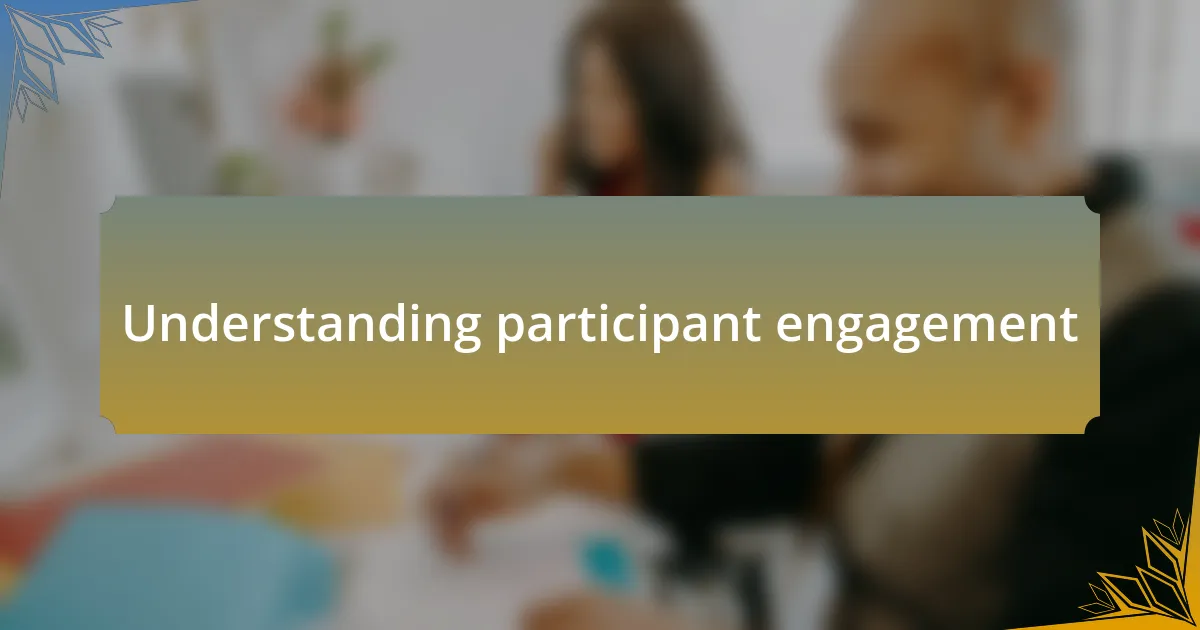
Understanding participant engagement
Participant engagement is the heartbeat of any session. I remember my first conference where I took a backseat, merely observing how attendees reacted to different approaches. It struck me that when facilitators encouraged questions and shared personal stories, the whole room lit up with energy and connection—showing me how vital it is to tap into that emotional layer of engagement.
When I think about what truly engages participants, I often reflect on their desire for interaction. Have you ever been in a session that felt like a monologue? It’s a quick way to lose interest. I’ve found that including breakout sessions or live polls not only fuels excitement but empowers participants to share their voices. It transforms a passive experience into an active dialogue, which is far more rewarding for everyone involved.
The dynamics of engagement are also influenced by how well you connect with your audience. I’ve had moments where simply acknowledging a participant’s contribution made them light up, reinforcing their involvement and encouraging others to join in. You start to realize that fostering engagement isn’t just about content; it’s about creating an environment where people feel valued and heard.
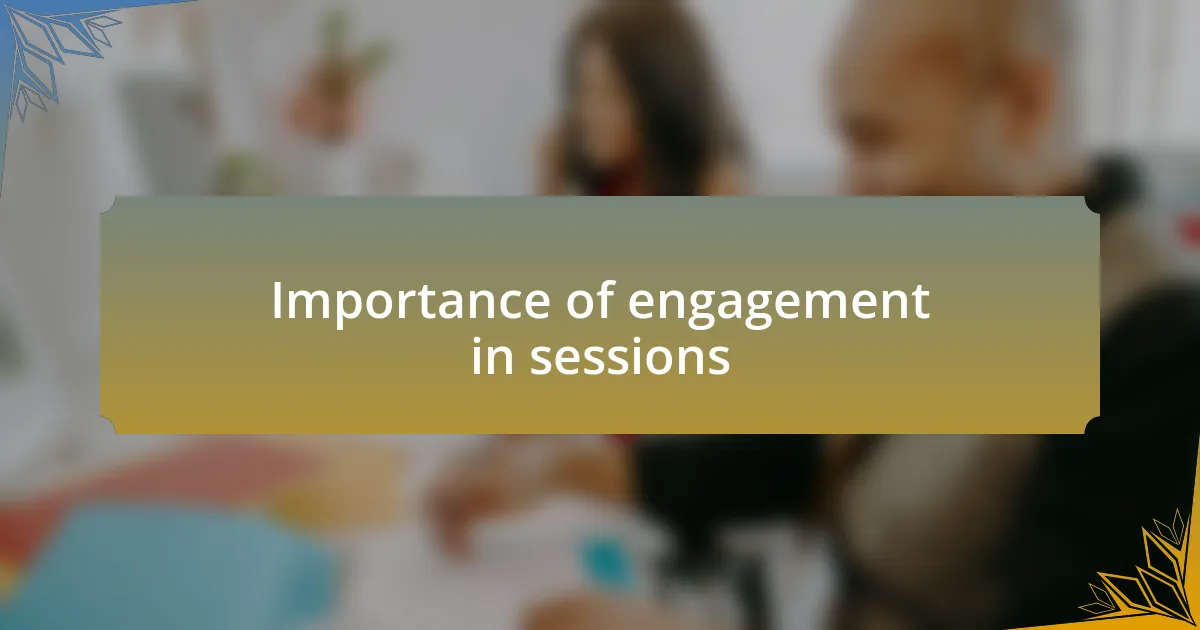
Importance of engagement in sessions
Engagement in sessions is crucial because it directly influences participants’ retention of information. I remember attending a workshop where the facilitator encouraged us to share our experiences related to the topic. I found myself reflecting on my own challenges, which not only deepened my understanding but also made the content resonate more. When participants can relate personally, they become invested, transforming a simple session into a memorable learning journey.
Why is it that some sessions leave us excited while others fade into the background? In my experience, it often boils down to engagement strategies. I once sat through a presentation that was so engaging, it felt like a conversation rather than a lecture. The speaker asked for our input continuously, prompting discussions that sparked new ideas. It’s moments like these that illustrate the magic of participation; it creates a collaborative atmosphere that enhances learning and builds community.
Moreover, engagement fosters a sense of belonging among participants. I’ve observed that when they see their peers actively participating, it encourages everyone to contribute, creating a ripple effect. There’s a palpable shift in the room—from a collection of individuals to a cohesive group working towards shared insights. Isn’t it remarkable how engagement can transform a session into a vibrant exchange of ideas? Understanding this importance enables us to craft experiences that not only inform but also inspire connections.
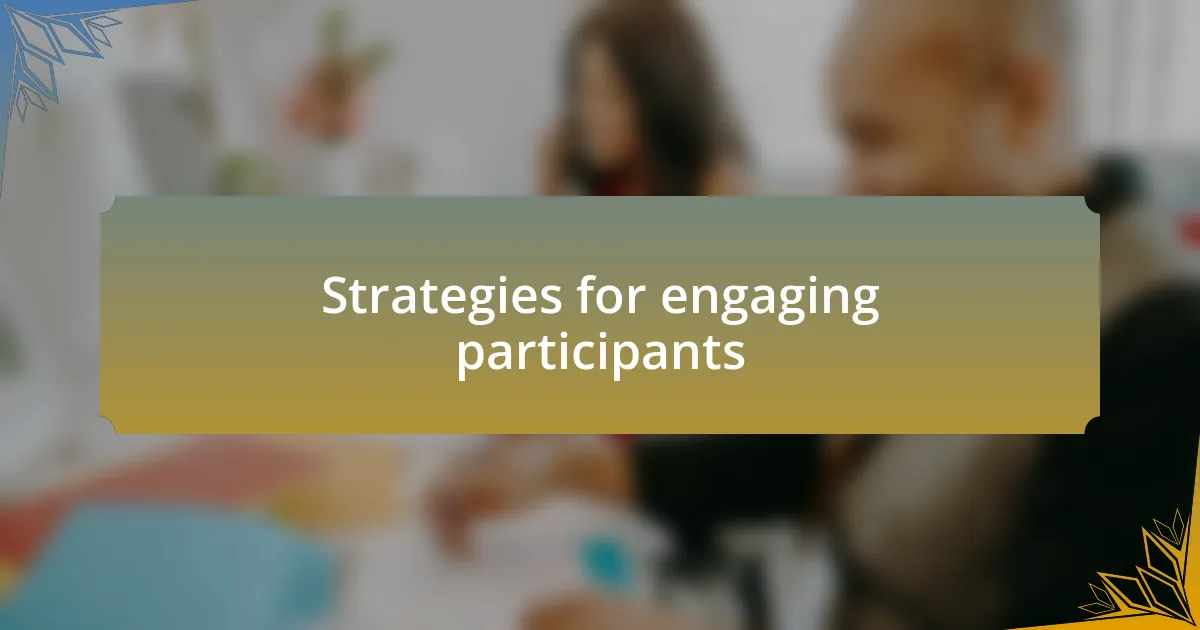
Strategies for engaging participants
One effective strategy for engaging participants is to incorporate interactive activities that break the ice early in the session. I vividly recall a time when a facilitator used a quick polling tool to gather our opinions on a topic relevant to the discussion. The results were displayed instantly, sparking an animated conversation that drew everyone in. Have you ever noticed how these small moments can transform the energy in the room? They encourage attendees to share their thoughts, making them feel like integral parts of the experience.
Using real-time feedback techniques, such as Q&A sessions, can also significantly enhance engagement. In one workshop I attended, the organizer dedicated time for us to ask questions throughout the presentation instead of saving them for the end. This approach not only kept the atmosphere dynamic but also made me feel that my voice truly mattered. Why wait until the end when participants are eager to dive deeper into the subject? Answering questions as they arise fosters a more meaningful dialogue and helps clarify any uncertainties on the spot.
Moreover, storytelling plays a pivotal role in connecting with the audience. I once shared a personal failure related to a session topic, and the reaction was immediate; others opened up about their struggles too. It was fascinating to witness how a simple story can dismantle barriers, creating an environment where participants feel safe to share their experiences. Isn’t it fascinating how vulnerability can foster connection? Using stories creates emotional resonance, enticing participants to engage not just with the material, but with each other.
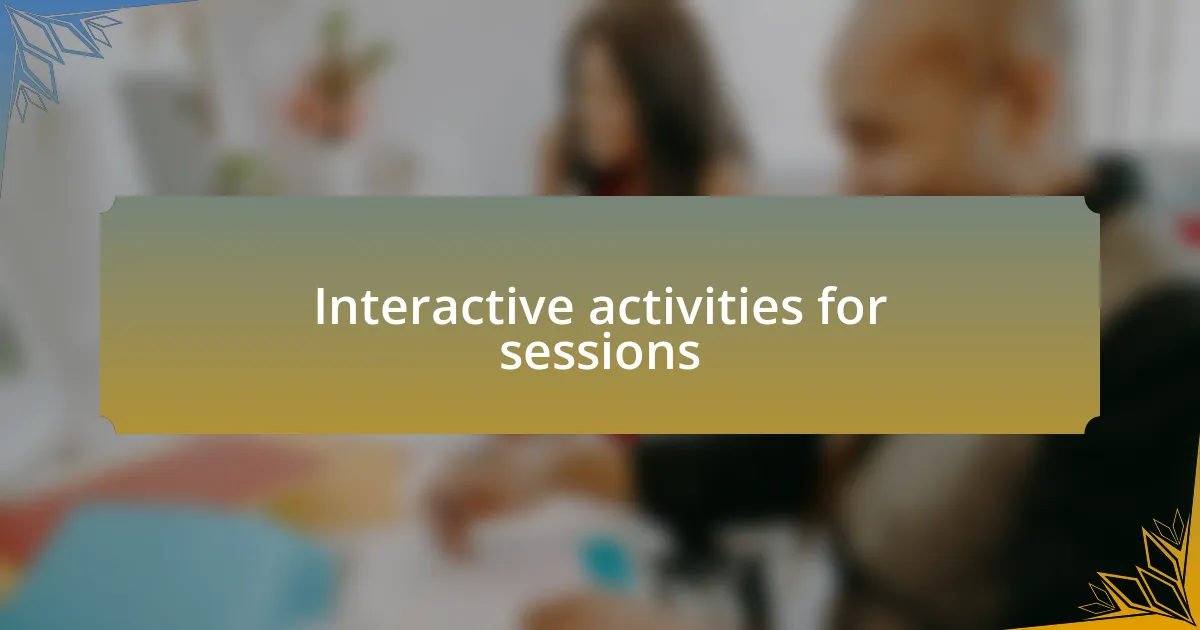
Interactive activities for sessions
Incorporating hands-on activities, like group brainstorming sessions, is a fantastic way to engage participants. I once facilitated a workshop where small groups were tasked with generating creative solutions to a common challenge. The laughter and excitement in the air as people bounced ideas around were palpable, and it struck me how collaborative efforts could reignite enthusiasm. Isn’t it incredible how collective thinking often leads to more innovative outcomes?
Another engaging strategy involves role-playing scenarios relevant to the session’s topic. During a recent conference, I participated in an exercise where we acted out customer service interactions. Watching others embody different roles not only heightened the session’s realism but also sparked insightful discussions about best practices. Have you ever realized how stepping into someone else’s shoes can deepen your understanding of their perspective? This technique often leads to breakthroughs that passive listening simply can’t achieve.
Gamifying a session can also work wonders for engagement. I’ve seen sessions turn into friendly competitions, where teams raced against each other to answer trivia questions related to customer experience. The excitement was infectious, and I could feel the energy shift palpably in the room. Isn’t it amazing how a little competition can ignite motivation and encourage collaboration at the same time? Using games as learning tools fosters a fun environment and reinforces the session content in memorable ways.
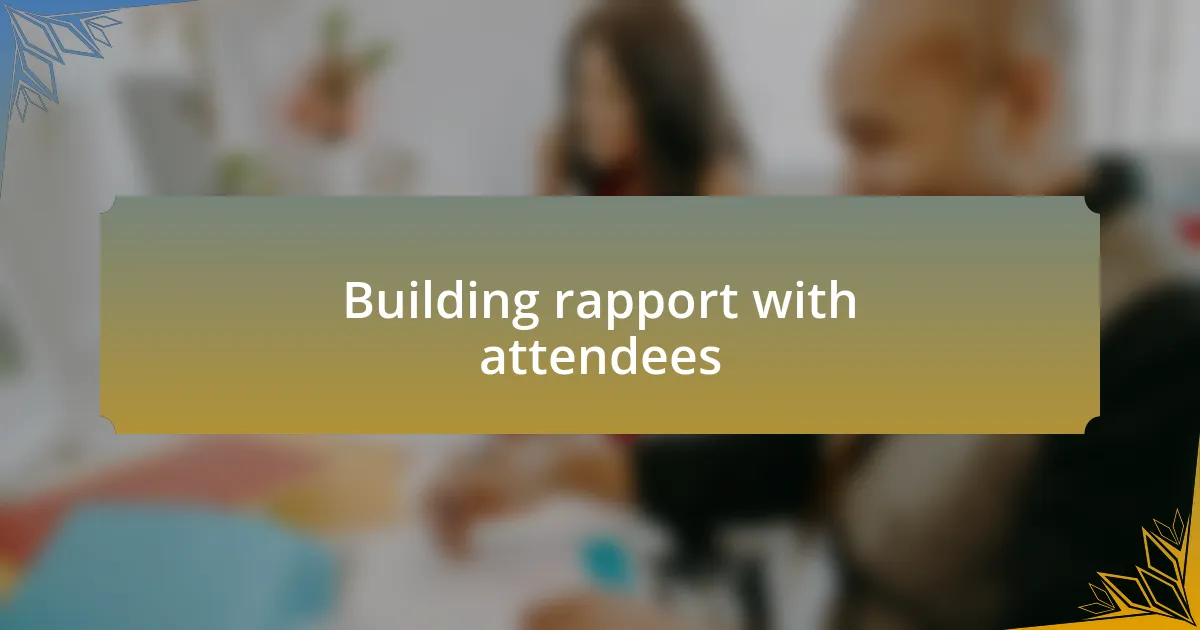
Building rapport with attendees
Building rapport with attendees starts with genuine interest. I remember attending a seminar where the facilitator took time to learn participants’ names and a little about their backgrounds. This simple act transformed the atmosphere; people felt seen and valued, which naturally opened up lines of communication. How often do we overlook the power of personal connection in a professional setting?
Sharing stories can also foster a sense of connection. During one conference session, I recounted a humorous mishap I experienced in customer service. The laughter that erupted created an immediate bond among the attendees. It’s fascinating how storytelling can break down barriers and prompt others to share their own experiences, creating a shared space of understanding and openness.
A warm, welcoming environment is essential in building rapport. Once, in a session I led, I decorated the space with personal touches and provided snacks that encouraged mingling. Almost instantly, attendees began chatting and laughing before the session even started. Have you ever noticed how comfort can spark connection? When people feel at ease, they’re more willing to engage authentically, which enriches the entire experience for everyone involved.
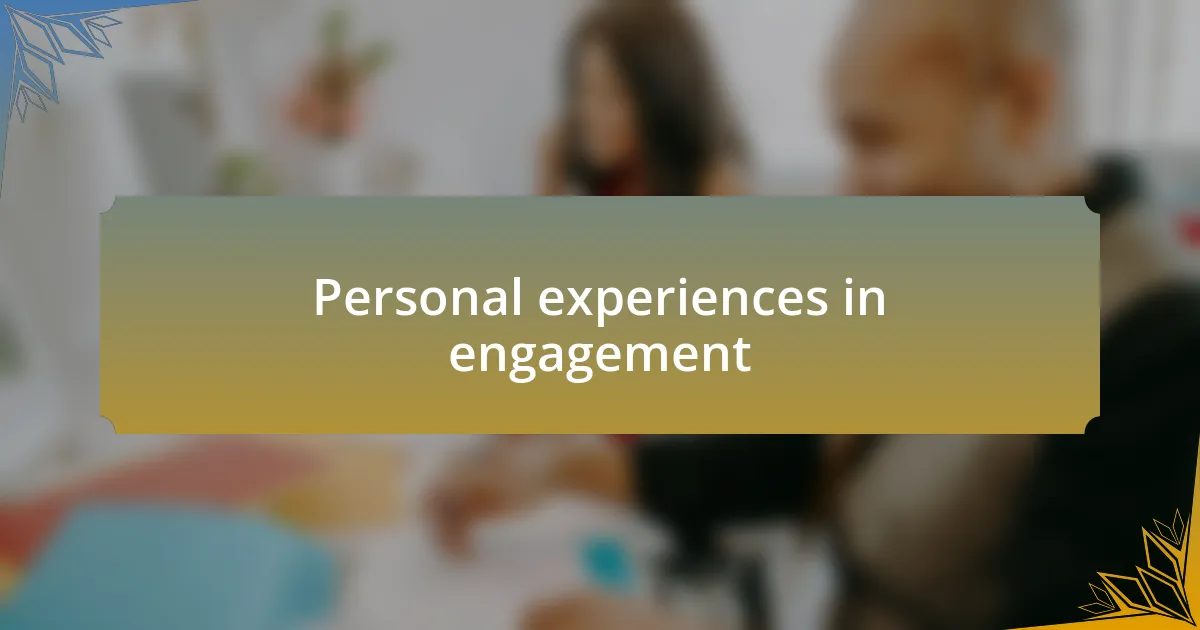
Personal experiences in engagement
Creating engagement goes beyond just inviting participation; it’s about making everyone feel like they belong. I once facilitated a workshop where I encouraged each participant to share one professional highlight from their career. Hearing their stories illuminated not just their successes but also their personalities. It was incredible how quickly the room transformed into a supportive community. Have you ever witnessed how shared achievements can bridge gaps between strangers?
In another instance, I incorporated live polls during a session to gauge real-time reactions. Seeing immediate feedback on the screen not only sparked lively discussions but also converted passive listeners into active participants. I felt a rush of excitement as attendees expressed their opinions, and I realized that opening channels for instant interaction can significantly amplify engagement. Isn’t it interesting how technology can enhance the ancient art of conversation?
I fondly remember a particular session where I introduced small group discussions on challenging topics. The energy shifted immediately; participants leaned in closer, sharing insights and learning from one another. Their faces lit up with enthusiasm and curiosity. It struck me how empowering people to discuss their challenges could lead to collective problem-solving. Have you experienced that moment when a group dynamic takes off, making every participant feel like they’re part of something larger?

Lessons learned from my sessions
During one session, I decided to break from the usual lecture format and experimented with an “open mic” approach. This setup allowed participants to voice their thoughts spontaneously, and I was amazed at how this encouraged everyone to contribute. It taught me that vulnerability can foster connection; having the courage to share ideas can turn a session into a collaborative dialogue rather than a one-sided presentation. Have you ever felt the energy shift when someone takes the first step in sharing?
A lesson that stood out was when I used storytelling to illustrate complex concepts. I shared a personal failure and the lessons it taught me, which resonated deeply with the audience. I noticed how people connected through shared experiences, breaking down barriers and creating space for empathy. This made me reflect on how authenticity in sharing can promote a deeper understanding among participants. Have you thought about the power behind revealing your own challenges in order to inspire others?
In another memorable session, I incorporated interactive activities that required participants to work together. One group created a mock customer journey map, and the creativity that emerged was inspiring. It reminded me that collaboration not only engages participants but also cultivates innovation. Seeing the enthusiasm when they realized they could leverage each other’s ideas was a powerful reminder of the magic that happens when people come together. How often do we underestimate the potential of collective brainstorming?